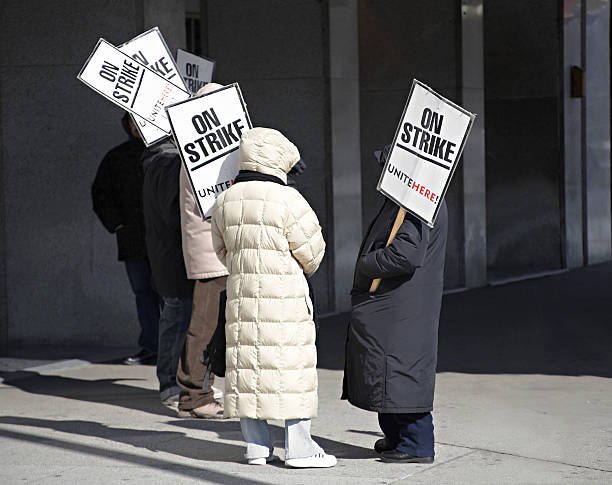Question: Distinguish between the primary strike and the secondary strike in terms of their procedures.
In the context of labor disputes, primary and secondary strikes are different methods employed by unions and workers to put pressure on an employer or a group of employers. Here’s how they differ in terms of their procedures:
Primary Strike
Definition:
A primary strike involves the workers of a particular company going on strike against their own employer.
Procedures:
- Vote to Strike: The union members must usually vote to approve a strike, often requiring a majority or supermajority to proceed.
- Notification: After approval, the union generally notifies the employer and possibly a government agency, depending on jurisdictional requirements.
- Picketing: Workers may establish a picket line outside their workplace to discourage strikebreaking and show solidarity.
- Negotiation: During the strike, union representatives and the employer continue to negotiate to resolve the dispute.
- End of Strike: Once an agreement is reached or some other resolution is found, the strike is called off, and workers return to their jobs.
Secondary Strike
Definition:
A secondary strike involves workers from one company striking in support of workers from another company who are involved in a primary strike.
Procedures:
- Initial Strike: A primary strike by another set of workers must already be in place for a secondary strike to occur.
- Union Approval: The union representing the secondary strikers generally needs to vote to support the primary strikers.
- Notification: The union of the secondary strikers typically must notify their own employer and possibly a government agency, similar to a primary strike.
- Limited Picketing: In many jurisdictions, picketing or other forms of protest by secondary strikers may be limited or regulated to avoid broader economic disruption.
- Alignment with Primary Strike: The secondary strike usually lasts as long as the primary strike or until the union decides to call it off.
- Resolution: The end of the primary strike often signals the end of the secondary strike, although this can vary.
Legal Considerations:
It’s essential to note that secondary strikes may be subject to legal restrictions in some jurisdictions, including the United States, making them less common than primary strikes.
Understanding these procedures can give you valuable insights into labor relations and the strategies that workers and unions use to fight for their rights and interests.
South African Examples
In the context of South Africa, labor disputes and strikes have played a significant role historically and continue to be relevant today. South Africa has its own set of labor laws, governed mainly by the Labour Relations Act (LRA) of 1995. Here’s how primary and secondary strikes may occur in South Africa, with hypothetical examples:
Primary Strike in South Africa
Procedures and Example:
- Vote to Strike: Union members in a South African manufacturing plant vote overwhelmingly to go on strike due to low wages and poor working conditions.
- Notification: The union submits the mandatory notice to the Commission for Conciliation, Mediation, and Arbitration (CCMA) and the employer.
- Picketing: Workers form a picket line outside the plant, carrying signs and banners calling for fair wages.
- Negotiation: During the strike, union representatives negotiate with the employer. They may involve the CCMA or other third parties to mediate.
- End of Strike: After two weeks, the company agrees to a 10% wage increase and improves working conditions. The workers end the strike and return to their jobs.
Secondary Strike in South Africa
Procedures and Example:
- Initial Strike: Miners at a gold mine go on a primary strike due to unsafe working conditions.
- Union Approval: A union representing workers at a separate processing facility related to the same mining company votes to go on a secondary strike to support the miners.
- Notification: The secondary-striking union also submits a notice to the employer and CCMA, as required by the Labour Relations Act.
- Limited Picketing: Workers at the processing facility form a smaller picket line. They don’t block entrances but hold signs supporting the miners.
- Alignment with Primary Strike: The secondary strike continues as long as the primary strike is ongoing.
- Resolution: After negotiations mediated by the CCMA, the mining company agrees to improve safety measures, leading to the end of both the primary and secondary strikes.
Legal Considerations:
- According to South Africa’s Labour Relations Act, secondary strikes are permissible if they meet certain criteria. They must be reasonable in relation to the nature of the primary strike, and the involved unions generally must notify the affected third parties.
Understanding the distinctions between primary and secondary strikes, particularly in the South African context, is crucial for comprehending the complexities of labor relations in the country.





